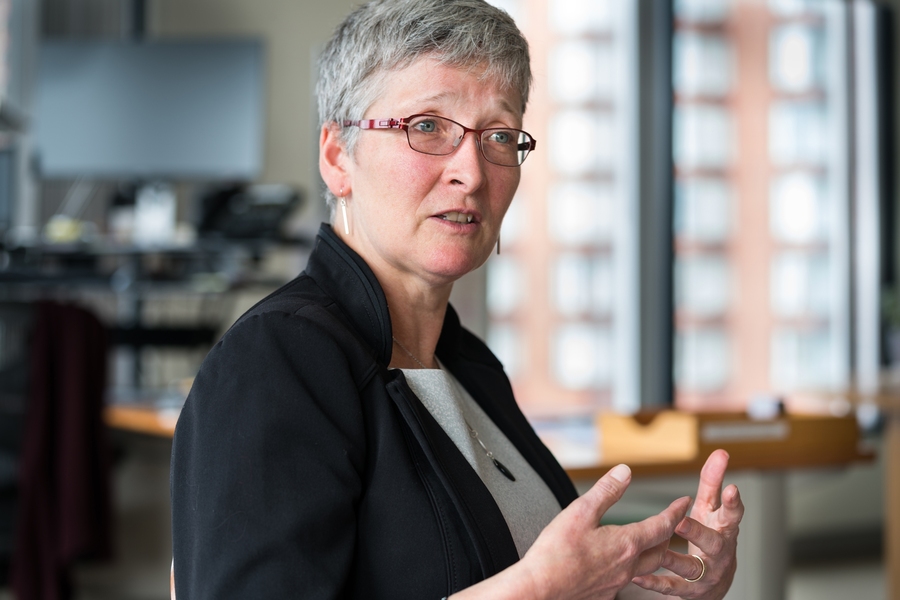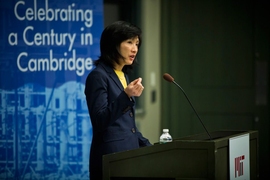When MIT engineers and scientists invent a new technology they think could find a foothold in the commercial marketplace, they come to the Technology Licensing Office (TLO). The office is responsible for all things related to MIT intellectual property. The TLO receives approximately 800 invention declarations each year. From those, TLO officers file 400 to 500 patent applications with the U.S. Patent and Trademark Office (USPTO), and they receive a green light for 200 to 300 of them. What’s more, the TLO manages a portfolio of over 2,500 already U.S.-issued patents and 1,500 pending U.S. patents for the Institute, as well as a myriad of foreign patents.
“That means there’s an awful lot of work going on,” says Lesley Millar-Nicholson, who, after 10 years at the University of Illinois at Urbana-Champaign, became the director of the TLO in July 2016. Millar-Nicholson sat down with the School of Engineering to demystify the role of the TLO, explain when scientists and engineers should use the office’s expertise, and describe the TLO’s strategy of patience for investing in new technologies.
Q: How does the TLO fit into MIT’s mission and innovation ecosystem?
A: One of MIT’s goals is to have global impact through research. Our part of that mission is to get technologies that arise from research into the hands of people who are going to develop them further, and hopefully, have an impact in society — whether it’s new vaccines, new types of technology for clean air or clean water, and so on.
Our role is a laundry list of things that aren’t exactly self-evident from our name. In general, we are receiving inventions, ascertaining with inventors whether there is something that may be commercialized, protecting the inventions by working through the U.S .Patent and Trademark Office to get patents issued, finding licensees — startups or other companies — negotiating the licenses, and if they create revenue, receiving consideration for the license, distributing that revenue back to inventors, academic departments, labs, and centers across MIT. Licensing is just one part of the complex operation of managing what is effectively one of the most prolific academic intellectual-property centers in the world.
Other, less obvious, activities include: working with researchers to enable them to transfer or receive materials from other academic or commercial entities, negotiating complex intellectual property [IP] terms in sponsored research or strategic engagements with corporations — such as the recent MIT-IBM Watson AI Lab. We provide advice and guidance for researchers wishing to make their work available via open source licenses. We also manage the MIT trademark and use of name by third parties. We work alongside innovation and entrepreneurship programs such as Sandbox and the Deshpande Center to ascertain IP ownership, or licensing needs. Our licensing officers make presentations across campus about IP, commercialization and strategic licensing topics. We welcome engagement with the MIT community to help advance knowledge and innovation.
Q: When is something really an invention?
A: There are four tests in the USPTO. Very basically they are: Is it patentable subject matter? (Certain things cannot be patented, for example laws of nature.) Then, is it new or novel? As in, is it known to the public already, and is it nonobvious? That means, is it something truly beyond the state of the art in an existing patent or known technology? Lastly, does the technology have ‘utility,’ does it provide some benefit and functionality? There are other questions we will ask of the inventors as we go through the disclosure process with them, but if we are seeking a patent these are some of the fundamental questions that will be asked. Note that we also we manage non-patentable technologies, such as copyright through open source and other licensing agreements.
MIT researchers who think that they have something which has potential for impact in the world, should come to see us if they’re ready to publish or present their work, or if they have any question about whether they should disclose information about their research — even if it’s just an abstract on the web or a social media site. Do come and talk to us. Publishing without protecting the invention means we might lose certain patent rights, which may be important for commercialization in the future. We have a simple invention disclosure process, which is completely online.
Q: What strategy does the TLO use to be successful?
A: We have to ‘keep the faith.’ The technologies we see are very early-stage, and it takes a lot of time and other investment — venture capital, for example — from others to fully develop a technology into a product or service. We, meaning MIT, invest in the technologies that are disclosed to us by devoting time and funding to getting the appropriate IP protection and finding licensees. The patent costs run upwards of $40,000 per U.S. patent, from filing through issuance and over its 20-year life.
When we file a patent, it takes at least two to three years to get it issued through the USPTO. A company might license it, but then it might take five to 10 years before a company actually makes products and creates revenue. So, that’s seven to 13 years from the first time the invention was disclosed to us to the point a company licensing the technology might be revenue positive. Those companies that do make revenue are still in the minority. Companies may fail, or technologies fail for all sorts of reasons.
However, that's why MIT built this ecosystem, to provide more opportunities for success for more companies willing to invest in MIT research. We have the luxury of having tremendous support from the administration and an appropriate budget to patent the technology. That's also why The Engine exists: patient capital, to recognize that there are technologies that are going to take a lot longer to develop which need longer-term support.
One of the recent standout examples we point to is digital TV. MIT enabled digital television through a significant number of patents that just expired. These patents brought a large revenue stream to MIT, and made a tremendous impact. What’s interesting is the length of time it took for the market to adopt the technology and ultimately to derive revenue, some of which was returned to MIT in the form of royalties: The original disclosure was made to the TLO in 1989, and MIT received 85 percent of its total licensing revenue between 2006 and 2014.
We play the long game here. We have to efficiently protect MIT’s intellectual property. We don’t play for revenue, we play for impact. We work closely with faculty and researchers to understand how their ideas might be commercialized, sometimes in markets that don’t exist yet. No crystal ball. Just pragmatism and patience.











